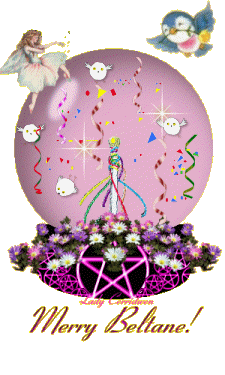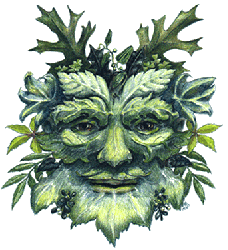![]()



A mixture of
recipes, charms and invocations can be found on Page 2
![]()
 |
|
Unite and unite and let us all
unite, |
![]()
Beltane
The old Celtic name for May Day is Beltane. The word Beltane means 'the fires of Bel', Bel being the Sky God and tan being the Welsh word for fire.
It was the custom in Celtic countries to extinguish all of the fires at sunset on the eve of May Day so that the element of fire would be absent through that night. At sunrise, a new fire was made ritually, kindling it with a wooden spindle turned in a wooden socket. From this, the Beltane or Need Fire was lit from the wood of nine different types of tree.
It was also the custom for Druids to kindle two Beltane fires and drive the cattle between the fires in a ritual to protect them before they were taken out to the summer pasture.
In addition, people would purify and protect themselves by going through or walking around the fires. Young men would leap through the fires to protect themselves and their livestock; older people would walk around the fires in prayer; as the fire died down, girls would jump across them to get good husbands, pregnant women would step through them to ensure an easy delivery, and mothers would carry their children through to protect from illness. A man about to go on a long journey, getting married or going on a dangerous undertaking would jump backwards and forwards through the fire three times to ensure good luck.
When it was time to go home, each family took an ember from the Beltane fires to re-light their hearth fires.
This practise
survived in Ireland and Scotland into the nineteenth centuary. In
the rural south of Ireland in the 1820's cows were made to leap
over lighted straw or wood in order to save the milk from being
stolen by the fairies.
![]()
May Day
On this day, throughout Europe, the fertility of the earth was reaffirmed and celebrated. Soon after midnight the young men and women of the comunity would meet in the earliest hours before dawn to go into the woods. Their purpose was twofold: to cut down and bring home the 'Maypole' tree, may blossom, and other greenery; and to practise the emotive and symbolic rite of mating. Traditionally the young people returning with the Maypole would also bring with them greenery and wild flowers from the forest with which to decorate the house exteriors and the Maypole itself. It was also traditional that Mayers should go from house to house announcing the arrival of spring with rhymes, songs and dances which varied in each district and each country across the whole of Europe. In return they were rewarded with gifts of eggs, dried fruit or cake. Those who refused to give anything were warned that their crops would fail and their house would not prosper. |
 |
These Mayers were led and presided over by the May Queen and King. They were a young couple who were chosen to epitomize the sacred marraige between the earth and the sky which had been consummated by the young in the fields and forests during the earliest hours of that day.
Traditionally May Day was spent in sport and pastimes, eating, drinking and dancing at the foot of the Maypole. The dancing was not done with the plaited ribbons suspended from the top of the pole that are used today, this is a modern custom bought to England from southern Europe where the Maypoles were considerably shorter.
![]()
 |
The Green Man A figure covered in green boughs was a central character in springtime festivities throughout Britain and much of Europe. Known variously as the Green Man, Jack in the Green, Jack in the Bush, the Garland, Robin of the Wood, Robin Hood, May Man, and King of the May. He is also associated with St George, who is known as Green George in some areas. Effigys of The Green Man can still be seen in many churches carved either in wood or stone. Traditionally in Britain, The Green Man was covered from head to foot by a wooden or wickerwork frame which was covered with interwoven branches of greenery, flowers and ribbons, so that the individual inside was completely hidden with only a peephole to see his way round as he danced among the merrymakers. He still plays a large part in many of the traditional May Day festivities throughout Britain. |
![]()
Padstow 'Obby 'Oss The world famous 'Obby 'Oss celebration, in Padstow, Cornwall, England, is on the 1st May. The origin of the Padstow 'Obby 'Oss lies in the mists of antiquity. It is probably one of the oldest survivals in the country, if not in Europe. There is reason to believe that the ancient British people had a settlement near the harbour mouth at Padstow and that the 'Obby 'Oss is a link with them and their times - four thousand years ago. On the day before May Day, the town is decorated with flags and greenery and a Maypole is set up in the town centre. The celebration of the first day of Summer commences at Midnight with unaccompanied singing around the town, seranading the occupents of various houses with words suited to the individual and set to a traditional tune. Then later, the 'Osses themselves appear. There are two main parties, Old 'Oss and Blue Ribbon, with more than one junior 'Oss. The Blue 'Oss is the first to appear at 10.am and an hour later, the Old 'Oss dances out from the Golden Lion. The construction of the 'Osses are unique. They are made up of a circular frame, around six feet in diameter, over which is stretched a shiny black oilskin, at the front of which is a small carving of a horse's head. A man stands in the middle, his legs obscured by the oilskin which hangs down from the edges of the frame. His head sticks out from the middle of the construction, but his face is covered by a pointed hat and a grotesque painted mask frightening in appearance. |
|
During the day accordians and drums accompany the respective parties around the town. As a curious break to the furious energy of the dance, at certain points the mood of the music will change, becoming slow and sad, at which point the 'Oss sinks to the ground, and the Mayers begin to sing a song invoking St George. The teaser then slowly strokes the 'Oss with his club, and after aloud crescendo of drumming the creature leaps up and the dance begins again.
Sometimes the 'Oss jumps towards a young woman and covers her with his skirt. This is taken to mean she will soon have a husband or a baby, and in earlier times the inside of the skirt with smeared with blacking which came off on the recipient of this 'good luck'.
Both 'Osses meet up at the square at the end of the day dance together. Then after the Farewell Song, the two 'Osses are restored in their stables and Padstow puts away its wonderful tradition for another year.
![]()
Flora Day, Helston, Cornwall, England
The Furry Dance always takes place on the 8th of May, which is the feast of the Apparition of St Michael, the patron saint of Helston, except when that falls on a Sunday or Monday, when the Dance is held on the previous Saturday. It is not clear where the word 'furry' came from, but it is possibly derived from the Cornish word for fair or jubilee- 'fer', or from the word 'foray' meaning sudden outing. The Furry Dance, is one of the oldest surviving customs in the Country, and is a celebration to the coming of spring and the passing of winter. Its origins are thought to be in pagan times, and no doubt it's association with St Michael was an attempt by the Christian Church to make this festival more acceptable.
|
The Helston
Town Band marches in front of the dancers playing the
'Floral Dance' tune. Dancers are arranged in groups of
four (two males and two females) and dance within that
group. The Furry Dance takes the form of a dignified
procession, with the gentlemen wearing top hats and tails
for the Principal Dance, and the ladies their finest
dresses. The children are all in white with the boys
wearing their school ties and the girls wearing a small
floral head bands. The morning and evening dance dress
code is slightly more relaxed with summery dresses and
shirts and ties as they were traditonally for the
servants. The dancers dance around the town for between about one hour (for the children's dance) to about two hours (for the midday dance). Traditionally, the dancers weaved in and out of houses and shops on their route, and this still occurs, though to a lesser extent now. As well as the four dances, at around 8.30 am a procession known as the Hal-an-Tow begins. Many people walk through the streets, all dressed up in varying costumes and periodically stopping, telling the story of George and the Dragon and singing a song to welcome the Spring. 7.00 am The First Dance |
![]()
Abbotsbury Garland Day, Dorset, England
Many areas in Britain still have Garland Days around May Day, this one is held only a few miles from where I live.
| Abbotsbury
Garland Day takes place each year on May 13th. It takes
place on Old May Day, according to the original calender,
which also coincided with the start of the fishing season. The village used to have its own small fishing fleet, and in the days when fishing families had their own boats, they made garlands which they showed off round the village. The garlands were then taken to the church for a service blessing before they adorned the prows of their owners' boats, and were then taken out to sea, where they were thrown into the water to bring good fishing. |
|
The custom has been kept alive by the children of the village, who make two separate sets of garlands, one of wild flowers and one of flowers from the garden. These are taken round the village to be admired, the bell-shaped garlands carried on poles between two children, and donations are made which are now given to charity. The garlands are then laid on the war memorial these days.
An officious policeman tried to put an end to the custom in 1954, when he stopped the procession through the village and seized the money that the children had so far collected, claiming that it was no more than an excuse to go begging. The children's parents, after organising a procession of protest, took their complaint to the Chief Constable. The custom proved stronger than the petty officiousness of a village policeman, who it seems was transferred. That it lives on is a tribute to the independence of a small Dorset village, and a reminder that the inhabitants once harvested the sea.
![]()
A mixture of recipes, charms and invocations can be found on Page 2
![]()